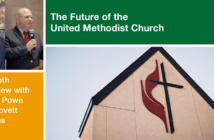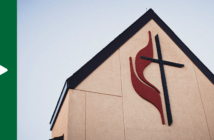Donald W. Haynes, a retired pastor and district superintendent, suggests that key questions raised by the Way Forward Commission should be considered in light of the history of other issues that divided Methodism and the consequence of those divisions. Haynes asks, do we risk the loss of voice in our own generation as our nation and world need our unified influence?
Times and issues change; human nature, sadly, does not. Most wars — military and ecclesiastical — are fought when cooler heads and calming spirits do not prevail. Today, many United Methodists — theologically “left” and “right” — predict that we are perilously close to denominational division.
Division came quickly
Methodism’s first division was in 1792, and the issue was polity. James O’Kelly, a Presiding Elder in southern Virginia, left the denomination. He founded The Christian Church on a theological foundation that he felt reflected the principles that Thomas Jefferson and James Madison embedded in the new republic. While he insisted that only the Bible would be the new denomination’s creed, he was adamant that every member of the new church read the Bible with “liberty of conscience.” What a marvelous term! If we could agree on this principle for scriptural interpretation today, we could retain United Methodism’s unity. “Liberty of conscience” is so close to Mr. Wesley’s words in a letter to a critic, “Though we cannot think alike, may we not love alike?”
Holiness divisions
Today’s spirit of “opposing camps” is a reminder of the 19th century divisions of Methodism over the doctrine of holiness, first resulting in the formation of the Free Methodist Church and then the Church of the Nazarene. I see sad and striking similarity between our debate over homosexuality today and the doctrinal debate over holiness in the 1850s and 1860s. The action of the 1860 General Conference resulted in the organization of The Free Methodist Church in upstate New York. The derogatory language then was “Old School Methodism” and “New School Methodism.” Both “sides” developed inflammatory labels: “Regency” for the “ruling elite” and “Nazaries” for the “holiness fanatics.” Interestingly, the Nazarites were for the abolition of slavery; whereas the Regency condemned only the “slave trade” and the prohibition of slaveholding by clergy.
Can the Holy Spirit empower The Way Forward and the Council of Bishops to create some modicum of Wesley’s catholic spirit that would become “a balm in Gilead to make the wounded whole”?
A leader of the Nazarites was B. T. Roberts of the Genesee Annual Conference that included the prestigious church he served, Niagara Street M.E. Church in Buffalo. Roberts’s emphasis was on temperance, opposition to slavery, and holiness. However, opposition to him grew out of his accent on sanctification as a second work of grace — a dimension of grace that he considered Wesleyan.
Following acrimonious debate at the conference of 1856, Roberts was sent to an appointment seen as a punishment. In the Genesee Annual Conference of 1858, Roberts was expelled, being denied a change of venue to the Oneida Conference or a civil court and prohibited from counsel or trial by committee. He appealed his case to the General Conference of 1860. Leland Scott opined, “By the time of the General Conference in May 1860, the controversy had left too much hurt in its wake for the Regency lion and the Nazarite lamb to continue to bed down in the same Wesleyan stall.” Roberts’s appeal resulted in a tie, allowing the annual conference expulsion to stand. (The 1910 M.E. General Conference acknowledged that Roberts’s credentials were unjustly taken, and his credentials were restored posthumously to his son, Rev. Benson Roberts.)
That was May 1860; in August, the Free Methodist Church was formed based on positions such as freedom from slavery, free pews, freedom from outward ornaments of pride, and “leaving at liberty the freedom of the Spirit in worship.”
Furthermore, we must note the tragic irony that the Church in 1860 was “fiddling while Rome burned.” Despite being a giant in both membership and influence, the Methodist Episcopal Church had already divided in 1844 between northern and southern branches over slave-holding by a bishop. Now, they were embroiled in the holiness divisions. It was only a matter of months after the 1860 General Conference that the secession of southern states began. The church was hardly a model for a divided nation.
Sadly, the debate and division over what today we call “perfecting grace” was not over. By the 1890s the doctrine was hotly debated so widely that the 1894 Episcopal Address at General Conference invited those of “holiness persuasion” to leave. Immediately district superintendents and bishops began what was called “push outism.” The response was the organization of the Nazarene Church whose organizers urged “come-outism” for Methodists who believed in sanctification as a second work of grace.
Lessons for today
As we replay today many of the scripts from the past, do we risk the loss of voice in our own generation as our nation and world need our unified influence? When we resort to judgmental language of each other’s conscience, where is our grace theology? At this very late date, is there not sufficient desire to so live that we can put away the issues that divide us and let some modicum of old-fashioned Wesleyan grace prevail? When I was a Fundamentalist in my twenties, I was touched by the gracious spirit of more liberal professors who still gave me an “A” on exams where essay questions allowed the professor a great deal of leeway in grading. The mantra of liberalism in my seminary days was the doggerel of Edwin Markham: “He drew a circle that shut me out — heretic, rebel, a thing to flout. But Love and I had a wit to win; we drew a circle that took him in.”
Where is that spirit today in our beloved United Methodism? Fundamentalism is not solely the province of one side. It is a posture that occurs when a religious person adopts a rigid position that will not listen to Isaiah’s plea: “Come let us reason together” (Isaiah 1:18). The NRSV translates this, “Come, let us argue it out.” How sad if we cannot adopt James O’Kelly’s “liberty of conscience” as we debate the questions dividing us now.
On one word of Jesus, we should all agree: “Why do you see the speck in your neighbor’s eye but do not notice the log in your own eye (Matthew 7:3-5)? Likewise, most of us believe that Jesus’s position on divorce was a proclamation against the rules for men who were allowed by Judaism to divorce their wives on a whim; but the fact remains that Jesus categorically said, “whoever marries a divorced woman commits adultery” (Matthew 5:32). Now who — conservative or liberal– wants that to be put into the Book of Discipline?!
The issues have changed, but human nature has not, nor has some of the acrimony of language. Do we not see similarities in the language and tone of debate in our own time?
We must ask:
- Will the widespread protests and lack of decorum in the U.S. government bleed over into our local congregations and impending General Conference? As the acrimony seems to mount, are we ignoring the angst in the public square that needs the voice of reason?
- Can the Holy Spirit empower The Way Forward and the Council of Bishops to create some modicum of Wesley’s catholic spirit that would become “a balm in Gilead to make the wounded whole”?
- After 156 years, The Free Methodist Church today has about 1000 churches in the United States with an average membership of 79 and an average attendance of 107. The Nazarene Church has 626,811 members. Would these numbers be the fate of a secessionist group between now and the 22nd century if a new Methodist denomination were to be formed in the 2020s?
The hour is frighteningly late.
Related Resource
- What’s at Stake When Schism is an Option? by Lovett H. Weems, Jr.




